Inhalt
Horseshoe crabs lived with the dinosaurs!
 Please visit our website, www.garethstevens.com. For a free color catalog of all our high-quality books, call toll free 1-800-542-2595 or fax 1-877-542-2596.Cataloging-in-Publication Data
Please visit our website, www.garethstevens.com. For a free color catalog of all our high-quality books, call toll free 1-800-542-2595 or fax 1-877-542-2596.Cataloging-in-Publication Data Names: Machajewski, Sarah. Title: Horseshoe crabs lived with the dinosaurs! / Sarah Machajewski. Description: New York : Gareth Stevens Publishing, 2017. | Series: Living with the dinosaurs | Includes index. Identifiers: ISBN 9781482456530 (pbk.) | ISBN 9781482456561 (library bound) | ISBN 9781482456547 (6 pack) Subjects: LCSH: Merostomata--Juvenile literature.
Classification: LCC QL447.7 M33 2017 | DDC 595.492--dc23 First Edition Published in 2017 by Gareth Stevens Publishing 111 East 14th Street, Suite 349 New York, NY 10003 Copyright 2017 Gareth Stevens Publishing Designer: Laura Bowen Editor: Therese Shea Photo credits: Cover, p. Rodger Jackman/Oxford Scientific. All rights reserved. No part of this book may be reproduced in any form without permission in writing from the publisher, except by a reviewer. Printed in the United States of America CPSIA compliance information: Batch #CW17GS: For further information contact Gareth Stevens, New York, New York at 1-800-542-2595. CONTENTS Words in the glossary appear in bold type the first time they are used in the text.
FROM ANOTHER TIME What was Earth like when dinosaurs the planet? Scientists think dinosaurs first lived about 245 million years ago. Humans werent alive then, so we dont have any records of it. Some species, or kinds, of animals that were around back then are still here today. Horseshoe crabs are one of them. Theyre almost 450 million years old! Horseshoe crabs are ancient creatures. They even look like something out of another time.
How has this species survived all these years? Lets take a closer look and find out. THE PREHISTORIC WORLD Plateosaurus was a dinosaur that walked on all fours and was nearly 30 feet (9 m) long. Horseshoe crabs didnt have to worry, though. Plateosaurus was a plant eater. 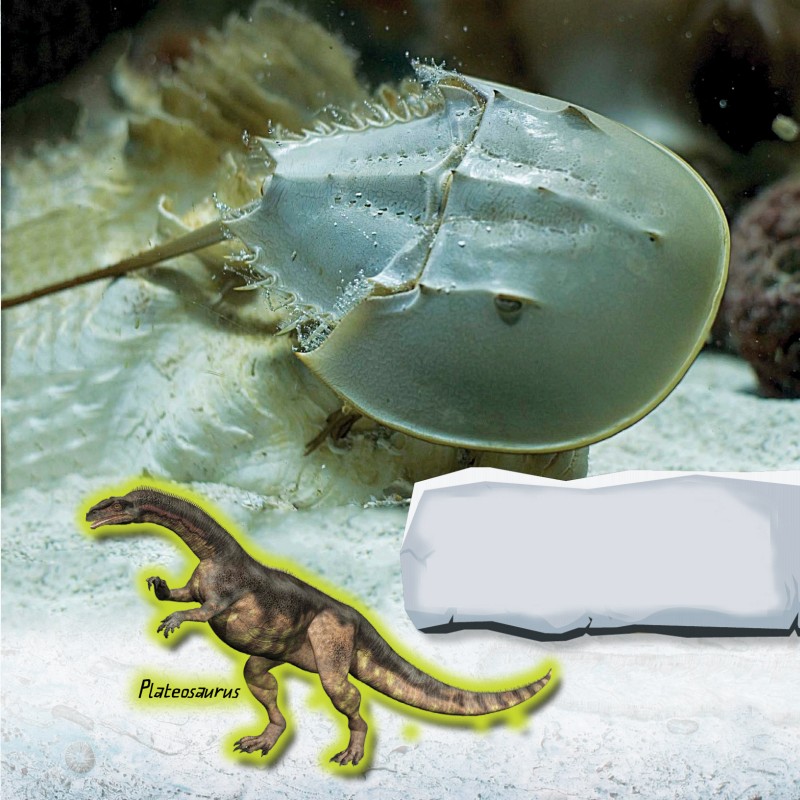 A HORSESHOE CRAB CAN LIVE TO BE 20 YEARS OLD. HOWEVER, THE HORSESHOE CRAB SPECIES IS PREHISTORIC.
A HORSESHOE CRAB CAN LIVE TO BE 20 YEARS OLD. HOWEVER, THE HORSESHOE CRAB SPECIES IS PREHISTORIC.
THAT MEANS IT WAS AROUND BEFORE RECORDED HISTORY! VERY, VERY OLD Horseshoe crabs have been on Earth longer than most creatures alive today. They lived before people, dinosaurs, and flying bugs. have been found that are between 444 million and 488 million years old! Todays horseshoe crabs look a lot like the horseshoe crabs that date back to about 200 million years ago. They havent changed much since then. For that reason, horseshoe crabs are sometimes called living fossils. 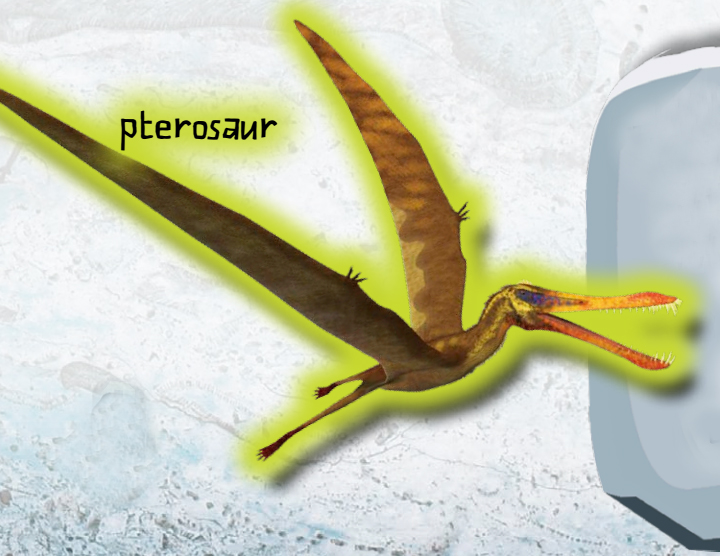 THE PREHISTORIC WORLD Horseshoe crabs once shared their world with the flying pterosaur, which was a cousin of the dinosaurs.
THE PREHISTORIC WORLD Horseshoe crabs once shared their world with the flying pterosaur, which was a cousin of the dinosaurs.
One species was 33 feet (10 m) from the tip of one wing to the other! 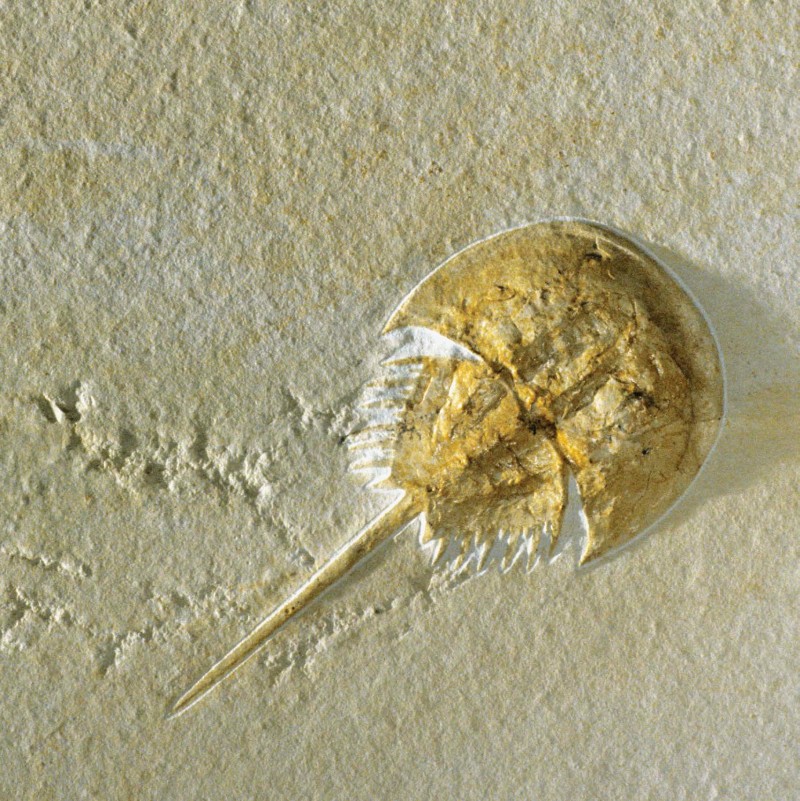 THIS HORSESHOE CRAB FOSSIL IS BETWEEN 145 MILLION AND 161 MILLION YEARS OLD. THE REMAINS LOOK LIKE A HORSESHOE CRAB YOUD SEE TODAY. AMAZING ARTHROPODS Horseshoe crabs belong to a group of animals called arthropods. Bugs, spiders, and true crabs are arthropods, too. Though their name may suggest something else, horseshoe crabs arent true crabs at all. They belong to their own class of animals called Merostomata (mehr-uh-STOH-muh-duh).
THIS HORSESHOE CRAB FOSSIL IS BETWEEN 145 MILLION AND 161 MILLION YEARS OLD. THE REMAINS LOOK LIKE A HORSESHOE CRAB YOUD SEE TODAY. AMAZING ARTHROPODS Horseshoe crabs belong to a group of animals called arthropods. Bugs, spiders, and true crabs are arthropods, too. Though their name may suggest something else, horseshoe crabs arent true crabs at all. They belong to their own class of animals called Merostomata (mehr-uh-STOH-muh-duh).
There are four species of horseshoe crabs. They live in different areas of the world. One kind lives along the eastern coast of North America and in the Gulf of Mexico. The other three species live in the waters of Asia, from Japan to India. 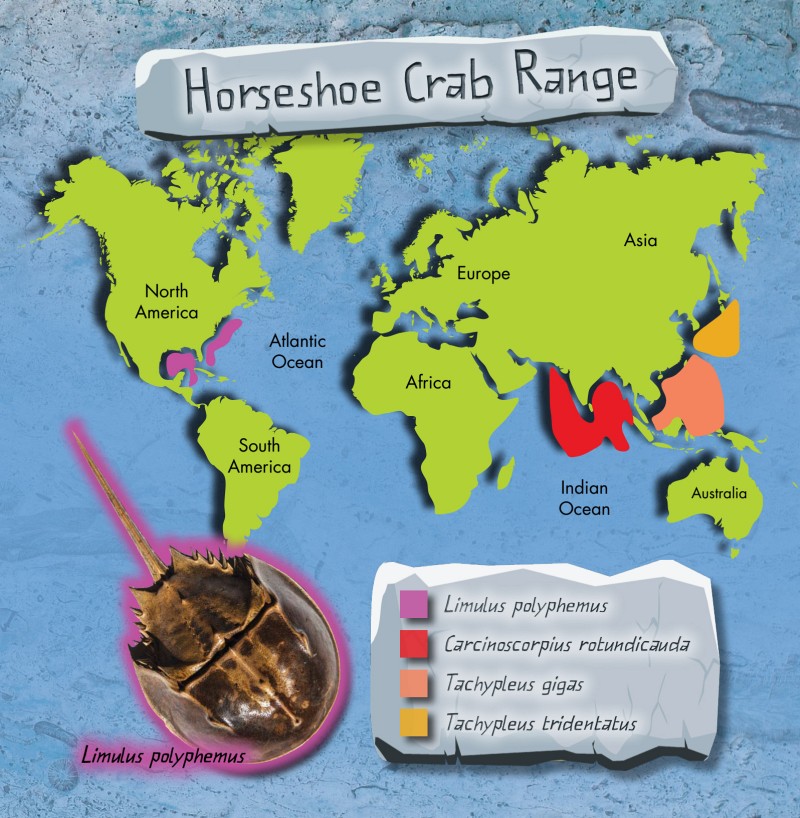 THE FOUR SPECIES OF HORSESHOE CRABS LOOK SIMILAR. THE SPECIES IN NORTH AMERICA, LIMULUS POLYPHEMUS, IS ALSO CALLED THE AMERICAN HORSESHOE CRAB OR ATLANTIC HORSESHOE CRAB.
THE FOUR SPECIES OF HORSESHOE CRABS LOOK SIMILAR. THE SPECIES IN NORTH AMERICA, LIMULUS POLYPHEMUS, IS ALSO CALLED THE AMERICAN HORSESHOE CRAB OR ATLANTIC HORSESHOE CRAB.
ANCIENT BODY The horseshoe crab hasnt changed much over millions of years. Its body is divided into three parts. The head, or prosoma, holds the brain, heart, and mouth. It has six pairs of legs. The first pair is used for catching prey. The other five pairs help the horseshoe crab walk and eat.
The abdomen contains for breathing. The tail, or telson, is the third main body part. If a horseshoe crab ends up on its back, it uses its telson to flip over. 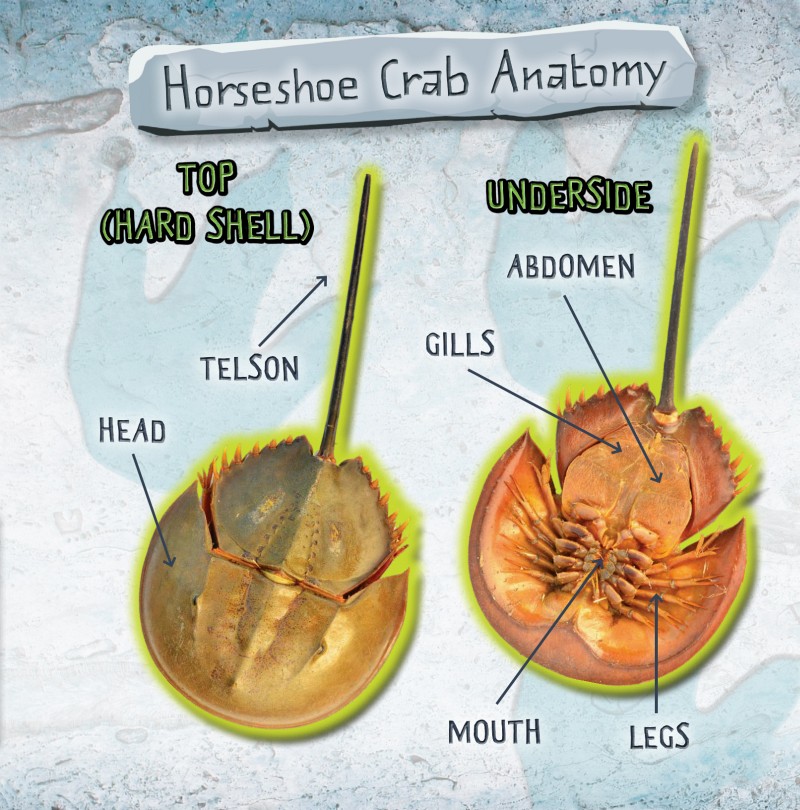 EVERY PART OF THE HORSESHOE CRABS BODY HAS HELPED THE SPECIES SURVIVE OVER MILLIONS OF YEARS. A HARD SHELL PROTECT THE ABDOMEN. THE LONG, POINTED TAIL HELPS IT STAY RIGHT SIDE UP.
EVERY PART OF THE HORSESHOE CRABS BODY HAS HELPED THE SPECIES SURVIVE OVER MILLIONS OF YEARS. A HARD SHELL PROTECT THE ABDOMEN. THE LONG, POINTED TAIL HELPS IT STAY RIGHT SIDE UP.
SEEING IN WATER Horseshoe crabs live in deep oceans and near coastal beaches. Their bodies have . They have many eyes that help them find their way. Two compound eyes are on each side of the shell. Theyre used for finding . Five eyes on top of the shell sense sunlight and a special kind of light people cant see, called ultraviolet light.
Two eyes on the underside of its body near its mouth help the horseshoe crab know where it is when its swimming. 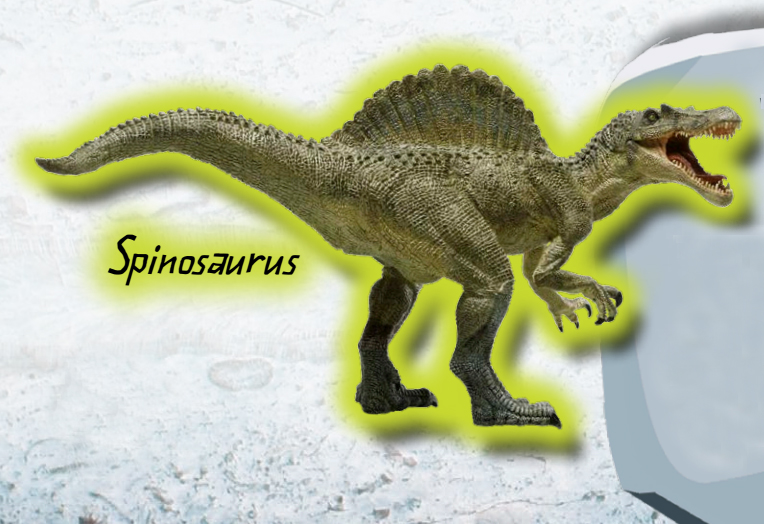 THE PREHISTORIC WORLD The dinosaur Spinosaurus swam in ancient waters, just like the horseshoe crab. Its the only known swimming dinosaur. Spinosaurus had a large fin-like part on its back and paddle-like feet.
THE PREHISTORIC WORLD The dinosaur Spinosaurus swam in ancient waters, just like the horseshoe crab. Its the only known swimming dinosaur. Spinosaurus had a large fin-like part on its back and paddle-like feet.  HORSESHOE CRABS EYES HAVENT CHANGED MUCH OVER MILLIONS OF YEARS. STUDIES OF THEIR EYES HAVE TAUGHT US A LOT ABOUT OUR OWN EYES.
HORSESHOE CRABS EYES HAVENT CHANGED MUCH OVER MILLIONS OF YEARS. STUDIES OF THEIR EYES HAVE TAUGHT US A LOT ABOUT OUR OWN EYES.
SPAWN POINT The horseshoe crabs survival depends on an activity as ancient as the crab itself. In early summer, horseshoe crabs leave the ocean at night and arrive on beaches for their season. Horseshoe crabs sense the moons ultraviolet light and know when its time to spawn. Female horseshoe crabs swim to beaches to lay their eggs. Nearby males locate them, and mates arrive on the beach together. 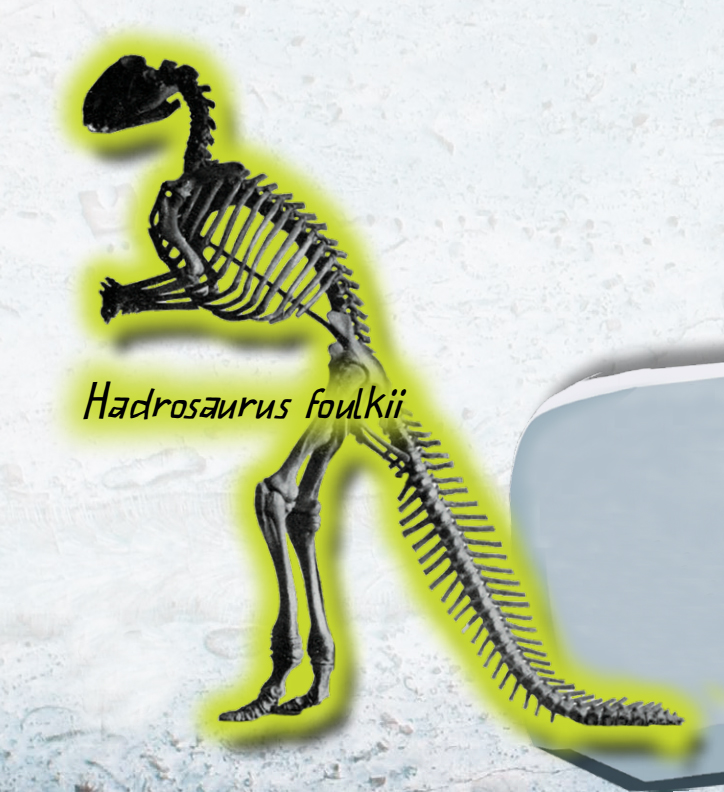 THE PREHISTORIC WORLD Fossils of the duck-billed dinosaur, Hadrosaurus foulkii , have been found in the Delaware Bay area of the United States, the same place where many horseshoe crabs spawn.
THE PREHISTORIC WORLD Fossils of the duck-billed dinosaur, Hadrosaurus foulkii , have been found in the Delaware Bay area of the United States, the same place where many horseshoe crabs spawn. 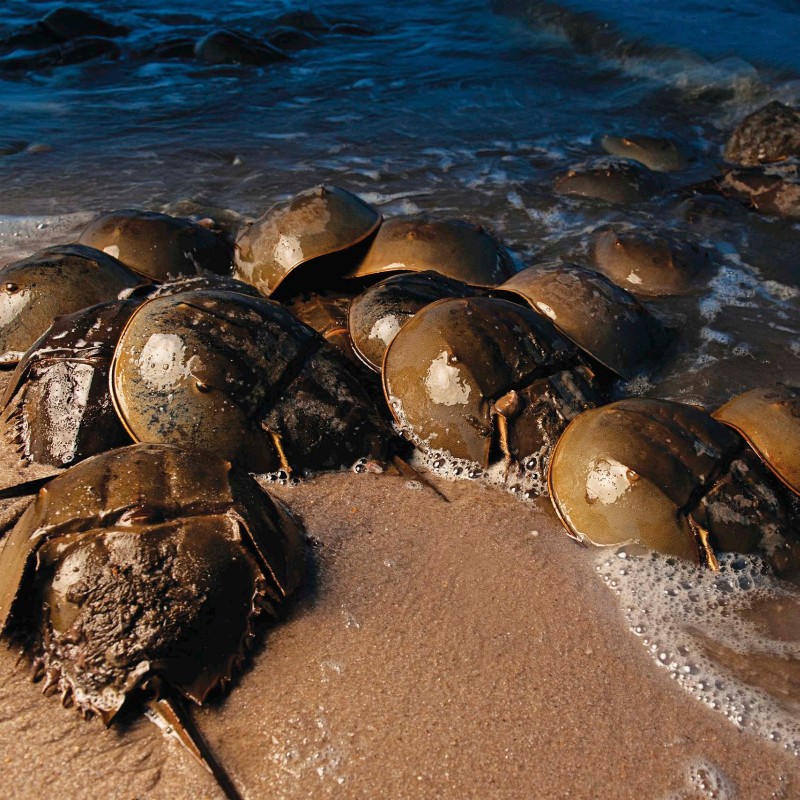 THE DELAWARE BAY IS THE LARGEST SPAWNING POINT IN THE WORLD FOR HORSESHOE CRABS.
THE DELAWARE BAY IS THE LARGEST SPAWNING POINT IN THE WORLD FOR HORSESHOE CRABS.  THE DELAWARE BAY IS THE LARGEST SPAWNING POINT IN THE WORLD FOR HORSESHOE CRABS.
THE DELAWARE BAY IS THE LARGEST SPAWNING POINT IN THE WORLD FOR HORSESHOE CRABS.
THE ACTIVITY YOU SEE IN THIS PICTURE HAS BEEN HAPPENING FOR MILLIONS OF YEARSLONG BEFORE PEOPLE WERE AROUND TO PHOTOGRAPH IT. THE LIFE CYCLE Horseshoe crab eggs hatch, or break open, after about 2 weeks. Larvae come out. The larvae look like tiny horseshoe crab adults with smaller tails. After hatching, larvae leave their nest and head into the water. They settle into the sandy ocean floor.




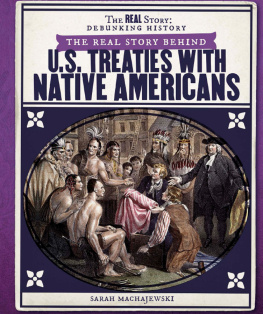



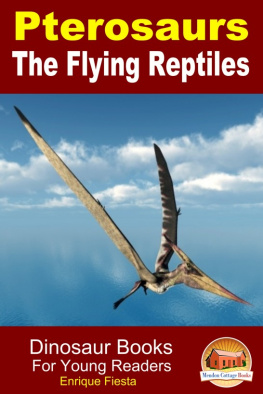
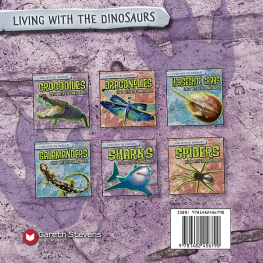
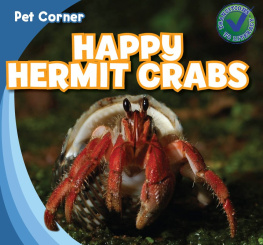

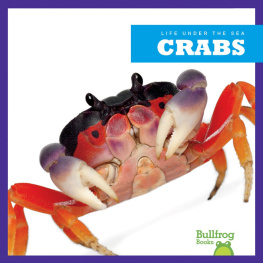
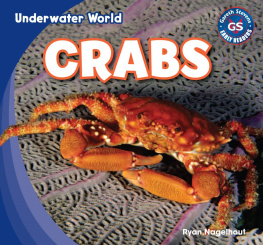
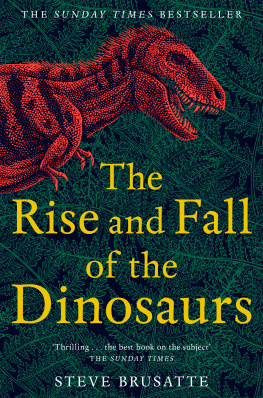
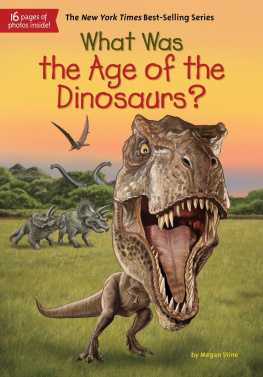
 Please visit our website, www.garethstevens.com. For a free color catalog of all our high-quality books, call toll free 1-800-542-2595 or fax 1-877-542-2596.Cataloging-in-Publication Data Names: Machajewski, Sarah. Title: Horseshoe crabs lived with the dinosaurs! / Sarah Machajewski. Description: New York : Gareth Stevens Publishing, 2017. | Series: Living with the dinosaurs | Includes index. Identifiers: ISBN 9781482456530 (pbk.) | ISBN 9781482456561 (library bound) | ISBN 9781482456547 (6 pack) Subjects: LCSH: Merostomata--Juvenile literature.
Please visit our website, www.garethstevens.com. For a free color catalog of all our high-quality books, call toll free 1-800-542-2595 or fax 1-877-542-2596.Cataloging-in-Publication Data Names: Machajewski, Sarah. Title: Horseshoe crabs lived with the dinosaurs! / Sarah Machajewski. Description: New York : Gareth Stevens Publishing, 2017. | Series: Living with the dinosaurs | Includes index. Identifiers: ISBN 9781482456530 (pbk.) | ISBN 9781482456561 (library bound) | ISBN 9781482456547 (6 pack) Subjects: LCSH: Merostomata--Juvenile literature.  A HORSESHOE CRAB CAN LIVE TO BE 20 YEARS OLD. HOWEVER, THE HORSESHOE CRAB SPECIES IS PREHISTORIC.
A HORSESHOE CRAB CAN LIVE TO BE 20 YEARS OLD. HOWEVER, THE HORSESHOE CRAB SPECIES IS PREHISTORIC. THE PREHISTORIC WORLD Horseshoe crabs once shared their world with the flying pterosaur, which was a cousin of the dinosaurs.
THE PREHISTORIC WORLD Horseshoe crabs once shared their world with the flying pterosaur, which was a cousin of the dinosaurs. THIS HORSESHOE CRAB FOSSIL IS BETWEEN 145 MILLION AND 161 MILLION YEARS OLD. THE REMAINS LOOK LIKE A HORSESHOE CRAB YOUD SEE TODAY. AMAZING ARTHROPODS Horseshoe crabs belong to a group of animals called arthropods. Bugs, spiders, and true crabs are arthropods, too. Though their name may suggest something else, horseshoe crabs arent true crabs at all. They belong to their own class of animals called Merostomata (mehr-uh-STOH-muh-duh).
THIS HORSESHOE CRAB FOSSIL IS BETWEEN 145 MILLION AND 161 MILLION YEARS OLD. THE REMAINS LOOK LIKE A HORSESHOE CRAB YOUD SEE TODAY. AMAZING ARTHROPODS Horseshoe crabs belong to a group of animals called arthropods. Bugs, spiders, and true crabs are arthropods, too. Though their name may suggest something else, horseshoe crabs arent true crabs at all. They belong to their own class of animals called Merostomata (mehr-uh-STOH-muh-duh). THE FOUR SPECIES OF HORSESHOE CRABS LOOK SIMILAR. THE SPECIES IN NORTH AMERICA, LIMULUS POLYPHEMUS, IS ALSO CALLED THE AMERICAN HORSESHOE CRAB OR ATLANTIC HORSESHOE CRAB.
THE FOUR SPECIES OF HORSESHOE CRABS LOOK SIMILAR. THE SPECIES IN NORTH AMERICA, LIMULUS POLYPHEMUS, IS ALSO CALLED THE AMERICAN HORSESHOE CRAB OR ATLANTIC HORSESHOE CRAB. EVERY PART OF THE HORSESHOE CRABS BODY HAS HELPED THE SPECIES SURVIVE OVER MILLIONS OF YEARS. A HARD SHELL PROTECT THE ABDOMEN. THE LONG, POINTED TAIL HELPS IT STAY RIGHT SIDE UP.
EVERY PART OF THE HORSESHOE CRABS BODY HAS HELPED THE SPECIES SURVIVE OVER MILLIONS OF YEARS. A HARD SHELL PROTECT THE ABDOMEN. THE LONG, POINTED TAIL HELPS IT STAY RIGHT SIDE UP. THE PREHISTORIC WORLD The dinosaur Spinosaurus swam in ancient waters, just like the horseshoe crab. Its the only known swimming dinosaur. Spinosaurus had a large fin-like part on its back and paddle-like feet.
THE PREHISTORIC WORLD The dinosaur Spinosaurus swam in ancient waters, just like the horseshoe crab. Its the only known swimming dinosaur. Spinosaurus had a large fin-like part on its back and paddle-like feet.  HORSESHOE CRABS EYES HAVENT CHANGED MUCH OVER MILLIONS OF YEARS. STUDIES OF THEIR EYES HAVE TAUGHT US A LOT ABOUT OUR OWN EYES.
HORSESHOE CRABS EYES HAVENT CHANGED MUCH OVER MILLIONS OF YEARS. STUDIES OF THEIR EYES HAVE TAUGHT US A LOT ABOUT OUR OWN EYES. THE PREHISTORIC WORLD Fossils of the duck-billed dinosaur, Hadrosaurus foulkii , have been found in the Delaware Bay area of the United States, the same place where many horseshoe crabs spawn.
THE PREHISTORIC WORLD Fossils of the duck-billed dinosaur, Hadrosaurus foulkii , have been found in the Delaware Bay area of the United States, the same place where many horseshoe crabs spawn.  THE DELAWARE BAY IS THE LARGEST SPAWNING POINT IN THE WORLD FOR HORSESHOE CRABS.
THE DELAWARE BAY IS THE LARGEST SPAWNING POINT IN THE WORLD FOR HORSESHOE CRABS.